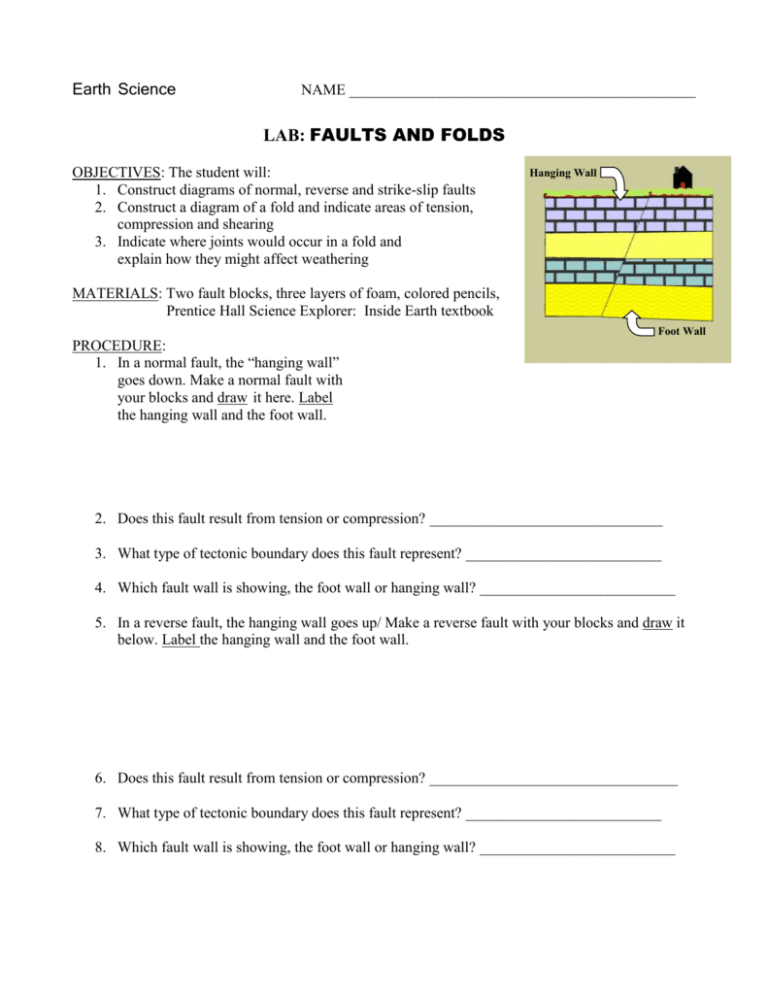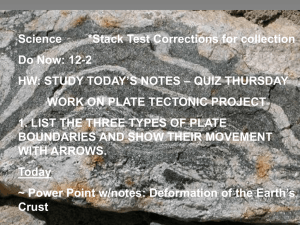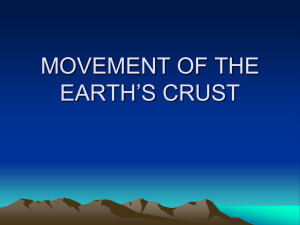Faults and Folds Lab: Earth Science Worksheet
advertisement

Earth Science NAME ______________________________________________ LAB: FAULTS AND FOLDS OBJECTIVES: The student will: 1. Construct diagrams of normal, reverse and strike-slip faults 2. Construct a diagram of a fold and indicate areas of tension, compression and shearing 3. Indicate where joints would occur in a fold and explain how they might affect weathering Hanging Wall MATERIALS: Two fault blocks, three layers of foam, colored pencils, Prentice Hall Science Explorer: Inside Earth textbook Foot Wall PROCEDURE: 1. In a normal fault, the “hanging wall” goes down. Make a normal fault with your blocks and draw it here. Label the hanging wall and the foot wall. 2. Does this fault result from tension or compression? _______________________________ 3. What type of tectonic boundary does this fault represent? __________________________ 4. Which fault wall is showing, the foot wall or hanging wall? __________________________ 5. In a reverse fault, the hanging wall goes up/ Make a reverse fault with your blocks and draw it below. Label the hanging wall and the foot wall. 6. Does this fault result from tension or compression? _________________________________ 7. What type of tectonic boundary does this fault represent? __________________________ 8. Which fault wall is showing, the foot wall or hanging wall? __________________________ 9. In a strike-slip fault, the movement of the ground is horizontal along the fault, side to side. Make a strike-slip fault with your blocks and draw it using an aerial view (from overhead). 10. Which type of force produces a strike-slip fault? ___________________________________ 11. Which fault wall is showing, the foot wall or hanging wall? __________________________ 12. Place the three layers of foam, in different colors, on top of each other. Push in equally on both ends, moving each end in about six inches. Make a drawing of the fold here, and label it as an “anticline”. Label the areas of the anticline that undergo tension or compression. 13. In what area of the fold would “joints” (cracks) most likely occur, due to stress? Draw them on your diagram? 14. How would this joint pattern affect the weathering (breaking down) of these rock layers? 15. A “syncline” is a sag, the reverse of an anticline. Draw and label one below. Reinforcement 1. Explain the miner's method of naming faults. Use a simple diagram showing the shaft, fault line, hanging wall, and footwall for normal and reverse faults. How did the walls get their names? 2. Name and describe the types of faults and folds that form in convergent margins. Use a simple diagram to illustrate your answer. 3. Name and describe the types of faults that form in a rift valley/mid-ocean ridge. Explain why normal faults form at divergent boundaries. Use simple diagrams to illustrate both answers. 4. Name and describe the types of faults that form along a transform boundary. Use a simple diagram to illustrate your answer. Faults, Plate Boundaries and Relative Motion Relative Motion of Layers or Plates Tension Compression Shearing or ho horizontal slip Fault Names Plate Boundary Description Divergent (moving apart, spreading, new lithosphere is added) Convergent (collision, seduction, moving toward, one plate thrust on top of another) Transform (translation, slide) Related Tectonic and Geological Features Rifts, shallow earthquake, valley Folded mountain ranges, uplift, volcano, deep ocean trench, shallow and deep earthquakes on subducted slab Steps between offset fault segments, oceanic facture zones, offset of mid-ocean ride, deep earthquakes






